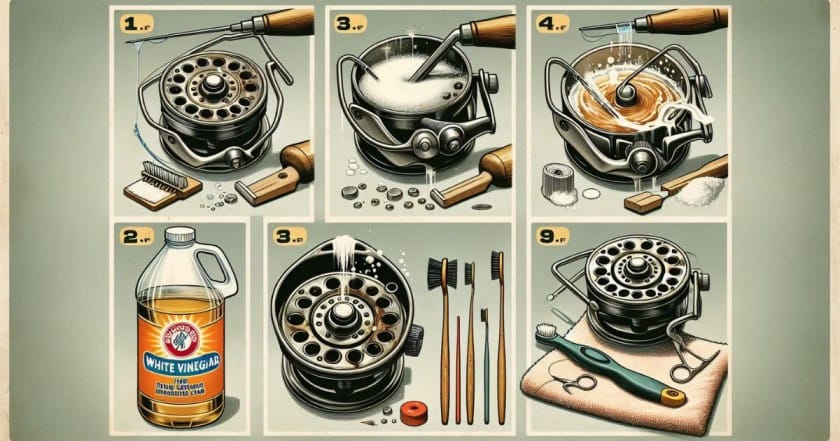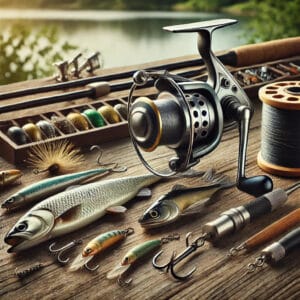Fishing reels are an essential component of any angler’s gear. They come in various shapes and sizes, and their durability is crucial to their performance. However, over time, fishing reels can become corroded due to exposure to saltwater, humidity, and other environmental factors. Corrosion can cause the reel to malfunction and, in some cases, become unusable. Fortunately, removing corrosion from fishing reels is a simple process that can be done with a few basic tools and some patience.
Understanding corrosion is the first step in removing it from fishing reels. Corrosion is a natural process that occurs when metal reacts with its environment. Saltwater, humidity, and other environmental factors can accelerate the corrosion process, causing damage to the fishing reel’s components. The severity of the corrosion depends on the type of metal used in the reel, the frequency of use, and the exposure to environmental factors.
Preparation for cleaning is crucial when removing corrosion from fishing reels. Before starting the cleaning process, it is essential to gather all the necessary tools and materials. These include a soft-bristled brush, a microfiber cloth, a cleaning solution, and a lubricant. It is also crucial to disassemble the reel carefully, taking note of the order and position of each component. This will make reassembling the reel easier and prevent damage to the components.
Key Takeaways
- Understanding corrosion is crucial in removing it from fishing reels.
- Proper preparation is essential before starting the cleaning process.
- Regular maintenance and professional care can prevent corrosion and prolong the life of the fishing reel.
Understanding Corrosion

Types of Corrosion
Corrosion is a natural process that occurs when metals are exposed to oxygen and moisture. There are several types of corrosion that can affect fishing reels, including:
- Uniform corrosion: This type of corrosion occurs evenly across the surface of the metal and can result in a loss of material. It is often caused by exposure to saltwater or other corrosive substances.
- Pitting corrosion: Pitting corrosion creates small pits or holes in the surface of the metal. It is often caused by exposure to saltwater, but can also be caused by exposure to acids or other corrosive substances.
- Crevice corrosion: Crevice corrosion occurs in tight spaces where oxygen and moisture are trapped, such as between two metal surfaces. This type of corrosion can be difficult to detect and can cause significant damage over time.
Causes of Corrosion on Fishing Reels
Fishing reels are particularly susceptible to corrosion due to their exposure to saltwater, which is highly corrosive. Other factors that can contribute to corrosion on fishing reels include:
- Improper storage: Fishing reels should be stored in a dry, cool place to prevent moisture buildup.
- Lack of maintenance: Regular cleaning and maintenance can help prevent corrosion from developing on fishing reels.
- Exposure to other corrosive substances: Fishing reels should be kept away from other corrosive substances, such as cleaning chemicals or gasoline.
By understanding the types of corrosion that can affect fishing reels and the factors that contribute to corrosion, anglers can take steps to prevent corrosion from developing and keep their fishing reels in top condition.
Preparation for Cleaning

Gathering Necessary Materials
Before starting the process of removing corrosion from a fishing reel, it is important to gather all the necessary materials. Here is a list of items required for cleaning a fishing reel:
- Soft-bristled brush
- Clean cloth
- Small container
- Vinegar or baking soda
- Q-tips or toothbrush
- Lubricating oil or grease
It is important to use a soft-bristled brush and a clean cloth to avoid any scratches on the surface of the fishing reel. A small container is required to hold the cleaning solution. Vinegar or baking soda can be used as a cleaning solution to remove corrosion. Q-tips or toothbrush can be used to clean the hard-to-reach areas of the fishing reel. Lubricating oil or grease is required to reassemble the fishing reel after cleaning.
Disassembling the Reel
The first step in cleaning a fishing reel is to disassemble it. The reel should be taken apart carefully, and each part should be kept in a separate container. This will help in keeping the parts organized and avoid any confusion while reassembling the reel.
It is important to take note of the order in which the parts are removed. One can take pictures or make a diagram to remember the order. The drag system, spool, handle, and other parts should be removed carefully, and the screws should be kept in a separate container.
After disassembling the reel, it is time to clean the parts. The next section will explain the process of cleaning the parts in detail.
Cleaning Process

Removing Surface Dirt
Before beginning the cleaning process, it is important to remove any surface dirt on the fishing reel. The dirt can be removed using a soft-bristled brush or a cloth. Ensure that the brush or cloth is not too abrasive, as this can damage the surface of the reel.
Applying Cleaning Solutions
After removing the surface dirt, it is time to apply the cleaning solution. There are various cleaning solutions available in the market, but it is important to choose one that is specifically designed for fishing reels. Apply the cleaning solution to a cloth or a soft-bristled brush and gently rub it onto the surface of the reel.
Scrubbing Corroded Areas
If there are any corroded areas on the fishing reel, it is important to scrub them gently with a soft-bristled brush. Avoid using abrasive materials, as this can cause further damage to the reel. After scrubbing the corroded areas, rinse the reel thoroughly with water and dry it with a soft cloth.
By following these simple steps, one can easily remove corrosion from a fishing reel and ensure that it functions properly. It is important to clean the reel regularly to prevent corrosion from building up and causing damage to the reel.
Rinsing and Drying

After removing the corrosion from the fishing reel, rinsing and drying the components is the next step. This is important to ensure that no chemicals or residue remain on the reel that could cause further damage.
Rinsing off Chemicals
To rinse off any chemicals or cleaning solutions used to remove the corrosion, use a hose or faucet with a gentle stream of water. Make sure to rinse off all components of the reel, including the handle, spool, and body. It’s important to use a gentle stream of water to avoid damaging any remaining parts of the reel.
If the reel has saltwater corrosion, it’s important to rinse it thoroughly with freshwater. Saltwater can cause further damage if left on the reel, so it’s important to rinse it off completely.
Drying the Components
After rinsing, dry the components of the reel thoroughly. Use a clean and dry cloth to wipe down all the parts. It’s important to ensure that all components are completely dry to prevent any rust or corrosion from forming again.
For hard-to-reach areas, use compressed air or a hairdryer set to a low heat setting to blow out any remaining moisture. Make sure to hold the hairdryer at least six inches away from the reel to avoid overheating and damaging any parts.
In summary, rinsing and drying the components of a fishing reel is an important step in the corrosion removal process. It ensures that no chemicals or residue remain on the reel and prevents further damage from occurring.
Reassembling the Fishing Reel

Once the corrosion has been removed from the fishing reel, it’s time to reassemble it. This can be a bit tricky, but with some patience and attention to detail, it can be done easily.
First, refer to the user manual or online tutorials to ensure that you know the correct order of the parts. It’s important to place each part in its proper place, as this will ensure that the reel functions properly.
Next, apply a small amount of reel grease to the moving parts of the reel. This will help to ensure that the reel operates smoothly and quietly.
Once all the parts are in place and properly lubricated, use a screwdriver to reattach the screws and secure the reel housing. Be sure not to overtighten the screws, as this can cause damage to the housing and other parts of the reel.
Finally, give the reel a test spin to ensure that it’s functioning properly. If everything is working smoothly, the reel is ready to be used again.
Overall, reassembling a fishing reel after removing corrosion is a relatively simple process, as long as you take your time and pay attention to detail. With a bit of practice, you’ll be able to do it quickly and easily every time.
Maintenance Tips

Regular Cleaning
To prevent corrosion on your fishing reel, it’s essential to clean it regularly. The frequency of cleaning depends on how often you use it and the conditions in which you fish. If you fish in saltwater, it’s recommended to clean it after every use.
To clean your reel, remove the spool and wipe it down with a clean cloth. Use a soft-bristled toothbrush to remove any dirt or debris from the reel’s body. Be sure to clean all the nooks and crannies, including the handle, drag knob, and bail arm.
For a more thorough cleaning, disassemble the reel and soak the parts in warm, soapy water for 30 minutes. Rinse the parts in clean water and let them dry completely before reassembling the reel.
Proper Storage
Proper storage is crucial to prevent corrosion on your fishing reel. After use, rinse the reel with fresh water to remove any salt or dirt. Wipe it down with a clean cloth and let it air dry.
Store your reel in a dry place, away from direct sunlight and humidity. A reel bag or case can provide extra protection from dust and moisture. Avoid storing your reel in a damp basement or garage, as this can accelerate corrosion.
Lubrication Advice
Lubrication is essential to keep your reel running smoothly and prevent corrosion. Use a high-quality reel oil and grease to lubricate the moving parts of your reel.
Apply a drop of oil to the bearings, spool shaft, and handle knob. Use a small amount of grease on the gears and other moving parts. Be careful not to over-lubricate, as this can attract dirt and debris.
By following these maintenance tips, you can prevent corrosion and extend the lifespan of your fishing reel.
Professional Care

Professional care is essential for maintaining the longevity and performance of fishing reels. Corrosion is a common issue that anglers face, and professional care can help prevent and remove it. Here are some tips for professional care of fishing reels:
- Regular cleaning: Regular cleaning of fishing reels is crucial to prevent corrosion. Anglers should clean their reels after every use, especially if they use them in saltwater. They can use a soft cloth and mild soap to wipe down the reel and remove any dirt or debris.
- Lubrication: Lubrication is another essential aspect of professional care. Anglers should regularly lubricate their reels to prevent corrosion and ensure smooth operation. They can use a high-quality reel oil or grease to lubricate the moving parts of the reel.
- Storage: Proper storage is also crucial for preventing corrosion. Anglers should store their reels in a dry and cool place, away from direct sunlight and moisture. They can also use reel covers to protect their reels from dust and debris.
- Professional servicing: Professional servicing is recommended for anglers who use their reels frequently or in harsh conditions. They can take their reels to a professional technician who can inspect and service the reel, including cleaning, lubricating, and replacing any worn-out parts.
By following these professional care tips, anglers can prevent and remove corrosion from their fishing reels, ensuring optimal performance and longevity.



